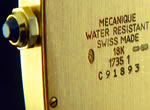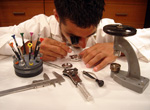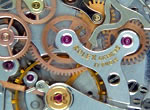AUDEMARS PIGUET
In 1875, in a laboratory in Le Bressus, Switzerland, Jules-Luis Audemars (1851-1918) and Edward-Auguste Piguet (1853-1919) founded this prestigious company. Audemars was a master in designing mechanical movements, whilst Piguet handled the financial and commercial side of the production.
As the company, along with its reputation began expanding, a decision was made in December 1881 to found the “Audemars, Piguet & Cie” company. However, the “Grande complication” was immediately used in the identification of the company. Living up to its name, in 1882, it created a pocket-model chronograph, with quarter repeater, perpetual calendar and independent seconds. Ten years later, in 1892, the Audemars Piguet developed the worlds first minute repeater wristwatch (watch ref. 2416).
In the first decade of the new century, the company grew to such an extent that it became necessary to expand the laboratory facilities. The new factory, founded in 1907, adjoined the company headquarters and could easily accommodate up to 70 workers. This favourable period ended with the approach of the First World War when the manufacture faced significant difficulties.
In 1918, the founders’ sons continued the business, reaping the rewards thanks to the highly- successful women’s wristwatches set with precious stones, and the complication watch models for men. Business was slowed by the approach of WWII but as the company had already achieved high recognition, it managed to survive the war, and in 1949 participated for the first time in the Basel Fair.
A new era began in the 1960s with the appointment of Georges Golay as the general director, and from 1966 to 1987, as the managing director. This was a period of considerable creativity in watch design, earning the company international success. In addition to this, distribution in the marketplace improved. The key to its charm was making watches with complex mechanisms, whilst exhibiting the spirit and tastes of the present. Some of the most popular models were, in fact, created in this period. For example the Audemars Piguet Royal Oak, instantly recognisable thanks to its octagonal bezel. This was a shape inspired by the canon mouths of the four HMS Royal Oak vessels, of the British Navy. This ship received its name in celebration of the popular oak used by King Charles II, who, after the battle of Worchester, found refuge from pursuers in the hollow of an ancient oak.
In 1986, the first ultra-thin self-winding tourbillon wristwatch was created. This was followed in 1989 with the launch of the first wristwatch to display the time in a second time zone. In 1991, the Audemars Piguet Star Wheel model was released characterised by a sectorial indication of the hour using three sapphire discs.
In 1992, Audemars Piguet Foundation was created, an organisation dedicated to the preservation of forests throughout the world, including the beautiful Vallè de Joux where the company developed and grew. On this occasion, they created the limited collection of the Audemars Piguet Royal Oak Foundation and, in the same year, they redesigned the famous “octagonal” watch in a sportsman model named the Audemars Piguet Royal Oak Offshore. A year later they founded the Audemars Piguet Museum, which is open by invitation only, and houses the company headquarters in Le Brassus.
In 1996, the Audemars Piguet Millenary Collection was launched, an unmistakable collection of watches with an oval-shaped dial, worn by the world chess champion Garry Kasparov, to whom a special model would be dedicated.
Since 1999, the company has been working to create eight limited-edition masterpieces in a series of twenty. Together these are known as the Audemars Piguet Tradition of Excellence Collection. In this collection is the Audemars Piguet Jules, Audemars minute repeater, the Audemars Piguet Jules and the Audemars dynamograph.
Forever fascinated by the nautical world, in 2000, Audemars Piguet decided to sponsor “Be happy”, the first Swiss challenger in the America’s Yacht racing Cup.
In 2003, the Company received more notoriety when Arnold Schwarzenegger, in the film Terminator 3, wore the Royal Oak offshore T3. Yet another great act of publicity came when the team Alinghi, sponsored by Audemars Piguet, won the 31st America’s Cup. To commemorate the victory, they released the Audemars Piguet Royal Oak City of Sails.
In 2004, Audemars Piguet launched the “Femmes du monde” a marketing campaign where the most beautiful women in the world wore Audemars Piguet watches and jewels.
In 2005, after several years of research, the exclusive self-winding Calibre 3120 was presented along with the Dual Time Millenari Maserati, named after the partnership of Audemars Piguet with the prestigious automobile manufacturer. This model also celebrated the Italian company’s 90th anniversary.
In 2006, three new models were added to the collection: the Audemars Piguet Millenary MC12, the Audemars Piguet cabinet n.5 Tradition of Excellence and the Audemars Piguet Millenary ladies watch.
In 2007 the Alinghi Team won the 32nd America’s Cup: Audemars Piguet paid tribute to the team with a new watch model, the Audemars Piguet Royal Oak Offshore Alinghi Team Chronograph.
 |
CHS CERTIFICATE » Certificate of Registration » CHS Card » Promotional Offers » CHS Services |
 |
EXPERTS » The Watch Market » Serial/Model Reference Numbers » Watch Maintenance » Swiss made |
 |
WATCH INFORMATION » Brand History » COSC » Guarantees » Contact Us |

